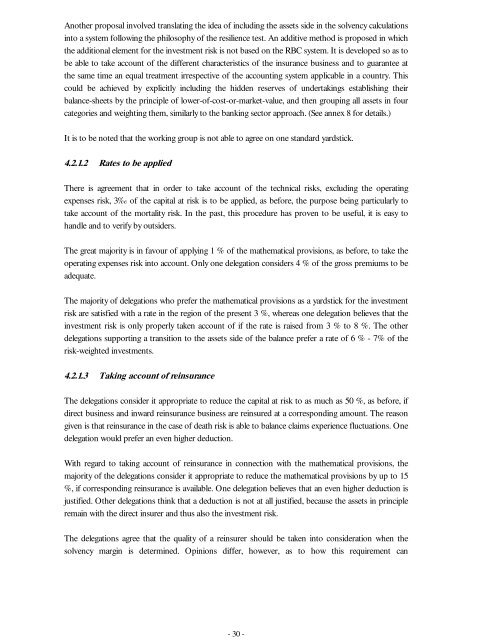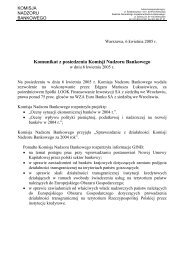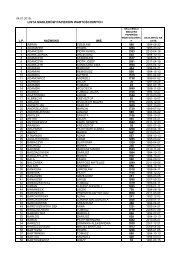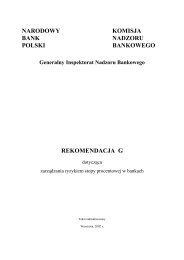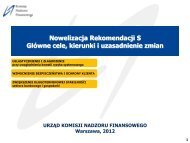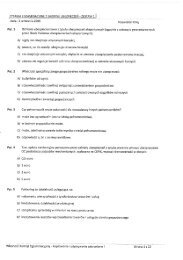Solvency of Insurance Undertakings (Mueller-Report) - Eiopa
Solvency of Insurance Undertakings (Mueller-Report) - Eiopa
Solvency of Insurance Undertakings (Mueller-Report) - Eiopa
Create successful ePaper yourself
Turn your PDF publications into a flip-book with our unique Google optimized e-Paper software.
Another proposal involved translating the idea <strong>of</strong> including the assets side in the solvency calculationsinto a system following the philosophy <strong>of</strong> the resilience test. An additive method is proposed in whichthe additional element for the investment risk is not based on the RBC system. It is developed so as tobe able to take account <strong>of</strong> the different characteristics <strong>of</strong> the insurance business and to guarantee atthe same time an equal treatment irrespective <strong>of</strong> the accounting system applicable in a country. Thiscould be achieved by explicitly including the hidden reserves <strong>of</strong> undertakings establishing theirbalance-sheets by the principle <strong>of</strong> lower-<strong>of</strong>-cost-or-market-value, and then grouping all assets in fourcategories and weighting them, similarly to the banking sector approach. (See annex 8 for details.)It is to be noted that the working group is not able to agree on one standard yardstick.4.2.1.2 Rates to be appliedThere is agreement that in order to take account <strong>of</strong> the technical risks, excluding the operatingexpenses risk, 3‰ <strong>of</strong> the capital at risk is to be applied, as before, the purpose being particularly totake account <strong>of</strong> the mortality risk. In the past, this procedure has proven to be useful, it is easy tohandle and to verify by outsiders.The great majority is in favour <strong>of</strong> applying 1 % <strong>of</strong> the mathematical provisions, as before, to take theoperating expenses risk into account. Only one delegation considers 4 % <strong>of</strong> the gross premiums to beadequate.The majority <strong>of</strong> delegations who prefer the mathematical provisions as a yardstick for the investmentrisk are satisfied with a rate in the region <strong>of</strong> the present 3 %, whereas one delegation believes that theinvestment risk is only properly taken account <strong>of</strong> if the rate is raised from 3 % to 8 %. The otherdelegations supporting a transition to the assets side <strong>of</strong> the balance prefer a rate <strong>of</strong> 6 % - 7% <strong>of</strong> therisk-weighted investments.4.2.1.3 Taking account <strong>of</strong> reinsuranceThe delegations consider it appropriate to reduce the capital at risk to as much as 50 %, as before, ifdirect business and inward reinsurance business are reinsured at a corresponding amount. The reasongiven is that reinsurance in the case <strong>of</strong> death risk is able to balance claims experience fluctuations. Onedelegation would prefer an even higher deduction.With regard to taking account <strong>of</strong> reinsurance in connection with the mathematical provisions, themajority <strong>of</strong> the delegations consider it appropriate to reduce the mathematical provisions by up to 15%, if corresponding reinsurance is available. One delegation believes that an even higher deduction isjustified. Other delegations think that a deduction is not at all justified, because the assets in principleremain with the direct insurer and thus also the investment risk.The delegations agree that the quality <strong>of</strong> a reinsurer should be taken into consideration when thesolvency margin is determined. Opinions differ, however, as to how this requirement can- 30 -


